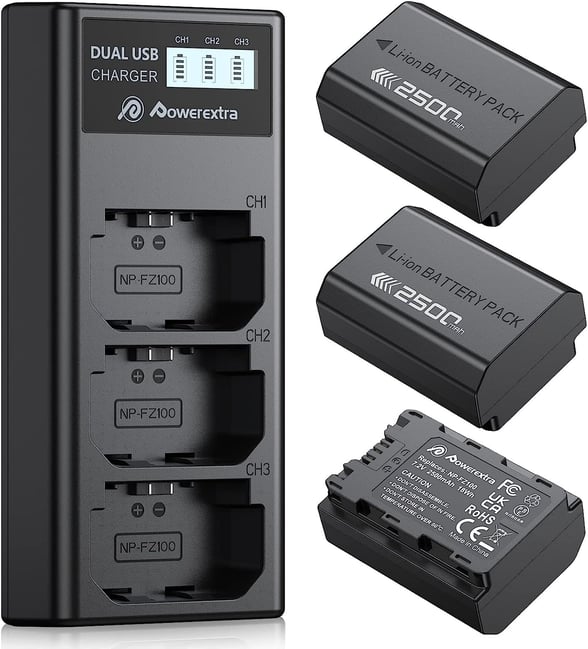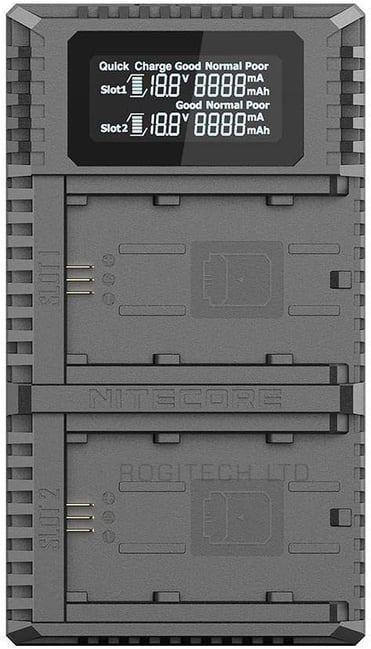If you’re shooting with a recent Sony camera, odds are you’re using NP-FZ100 style batteries. Sony’s OEM battery is quite expensive, but is it worth it? In this guide, I’ll take a look at some of the battery options for cameras like the a7R V, FX3, FX30, a7S III, and a1.

Table of Contents
NP-FZ100 Batteries
Sony’s Official NP-FZ100
Sony’s OEM battery is the most expensive, but is also going to offer the greatest guarantee of compatibility with future models and firmware updates. Whether that’s worth it to you is a tough call – in both testing and use, I found little performance difference with 3rd party batteries, making the price difference difficult to justify. Sony’s batteries are available from B&H for around $78 a battery.
The primary reason to pick the official NP-FZ100 over any third-party battery is firmware compatibility. Some firmware versions for certain cameras, like the FX30 V3.0 firmware, have broken compatibility with some non-Sony NP-FZ100 batteries. While the camera still operates, it might display a warning message, not display a battery-remaining percentage, or other strange behaviors. The rest of the batteries in this article are those which did not experience such issues in my testing. (If you have experience to the contrary, please let me know in the comments, since I can’t test every combination of camera + battery + firmware on the market.)
Watson NP-FZ100
Available from B&H, the Watson NP-FZ100 is about 65% of the Sony’s cost while offering a similar capacity. In terms of features, this battery doesn’t have some of the specialty offerings of other third party options (more on that in a moment), but does easily slot in as a replacement for Sony’s. Watson batteries are available from B&H for around $50 a battery.
Nitecore NP-FZ100
Nitecore’s battery has a nice quality of life feature: built in USB-C charging. Charging a spare while shooting, or even being able to leave the bulky dedicated charger at home, is definitely a nice perk. The Nitecore battery also includes a small LED-based readout of battery charge levels, a helpful way to check whether a battery is fresh or used without needing to load it into the camera. Whether that convenience is worth the extra $10 MSRP over the Watson is up to you. Nitecore’s NP-FZ100 batteries are available for around $60 a battery.
SmallRig NP-FZ100
SmallRig’s battery also features USB-C charging and a charging status LED. While the LED on the SmallRig battery can’t be triggered on demand, like Nitecore’s implementation, it’s still a great way to see charge status while using USB-C power. Additionally, SmallRig rates their capacity as slightly higher than some of these other options, at 2400 mAh rather than 2250 mAh.
This difference is small enough not to be of major importance (less than a 7% boost), but it is welcome nonetheless, and I noticed a small improvement in my testing. I think the real value from the SmallRig battery comes from the combination of a reasonable price point for a feature rich battery, at around $45, combined with the backing of a recognizable name brand.
PowerExtra NP-FZ100
Similar to the Watson, PowerExtra’s offering is a straightforward battery replacement with no extra features. The claimed capacity is the highest yet, at 2500mAh, but it didn’t yield longer runtimes in my testing. The real value comes from the great price per battery. The 3 pack, with an included triple bay charger, is only $56, putting each individual battery at less than $20. At that price, they’re such a good value that I’m no longer worried about the risk of future firmware updates.
An Alternative: USB-C Charging
Instead of getting a full set of batteries to keep your camera charged all day (and all trip), an alternative is to use the USB power delivery that’s built into Sony’s current cameras. You could have just one or two NP-FZ100 batteries, plus an external battery pack that you use for charging over USB-C.
There are many such options, including the Smallrig VB99 that I previously covered in this review and the similar FJDynamics V mount battery. Both of those battery packs are expensive and unwieldy if your only usage is still photography, but they’re ideal for video rigs where you’ll be chewing through batteries quickly (or simultaneously charging other gear like lights and mics).
If you’re looking for a less expensive option, there are a range of general use USB-C PD power banks available at a wide variety of prices. Perhaps you have one already. If not, I’ve trusted Anker’s products in the past, and I’d recommend their PowerCore+ model at $79.
Spare and Replacement Chargers
Sony’s OEM charger is an exorbitant $98. Third-party chargers are not only cheaper, but many of them are more advanced, and they’re relatively future-proof. (It’s possible that a future version of Sony’s NP-FZ100 battery will not be compatible with the charger, only with the official Sony charger, but this strikes me as fairly unlikely.) I’ll go through a few of the options quickly to wrap up this article.
PowerExtra Charger
Bundled with the 3 pack of PowerExtra batteries that I mentioned earlier, PowerExtra’s charger is a great option for users who need to recharge a bundle of batteries quickly. It has a three-slot design and supports simultaneous recharging. It can take power via USB-C or micro USB. While the display is much more basic than Nitecore’s, it still provides a three-segment readout of the charge of each battery individually. This charger isn’t available individually at the time of writing, but the low implied price in combination with three batteries makes that combo an even better value.
Nitecore Charger
Nitecore’s FPZ charger is a compact option, with a nice industrial design and the smart choice of USB for a power supply. The biggest drawback is the location and port for USB. The micro USB port, tucked away on the bottom, is both cumbersome to use and a concerning point of failure. I’d prefer to see a version of this charger with USB-C right on the side of the device. The Nitecore charger is available from Amazon for $30.
Watson Charger
Watson produces two models of charger compatible with the NP-FZ100: a dual bay model that takes a micro USB input, and a single bay model with built in AC prongs and support for DC car charging.
The dual bay model supports simultaneous charging, making it a slight step up from Sony’s official charger, although there may be some concerns with longer term durability, based on customer reviews. Meanwhile, the AC/DC model is definitely for a particular niche – I can’t personally remember the last time I reached for a DC car charger. If you’re in that situation, however, this could be just what you’re looking for.
Conclusion
Overall, I’m quite pleased with all the third-party options I tested, both for batteries and chargers. Sony’s very high pricing for replacement batteries or chargers has left a ton of room in the market for third-party companies.
Sony has started to implement some firmware-based checks against these products, however, so things aren’t perfect. Still, even if these batteries do have a shorter lifespan, in some cases you can replace them 4 or 5 times for the same price as a Sony battery and charger. Combine that with added features like built-in USB charging, and I think it is perfectly reasonably to get a third-party battery for your Sony camera these days.








Wasabi
Well, I could imagine that when a Sony camera notices a third party battery, it is recorded in the camera and might have some impact on warranty claims. But that is only speculation.
On the other hand the quality of third party batteries can actually be dubious and to me it makes no sense to use them instead of the official ones. My A7R V cost more than 4000€, so i really don’t see the point to use a some third party batteries just to save a few Euros or so.
Unfortunately, the latest firmware of the A7IV detects the alternative batteries and generates an annoying message every time the camera is turned on, which wastes valuable seconds for those of us who do action photography.
Maybe someone should take Sony to court and force them to remove these annoying messages. After all, the camera no longer belongs to them as you have bought it and it’s your choice how to use it.
There have been cases where third party phone battery bursted into flames (first party too, but rarely). News will then say that “phone X burned its owner and half of the house” but won’t mention third party battery.
There have been a few tear downs of cheap third party camera batteries and either chips for calibration, thermal sensors or other security things were missing. I know the camera manufacturers are making a huge profit on batteries but I’d at least use a high quality third party manufacturers, if not the original ones. I only have genuine batteries but I don’t need too many. If I was shooting video I’d probably think about cheaper alternative.